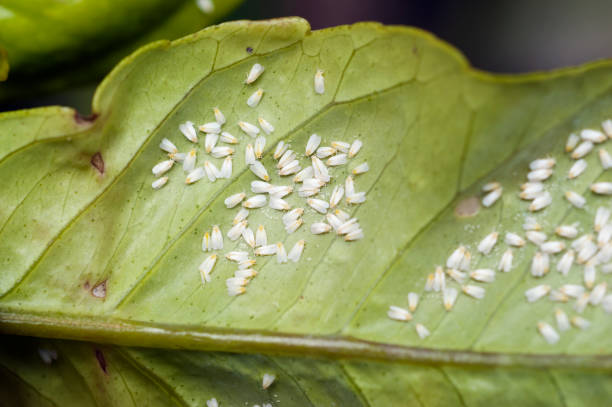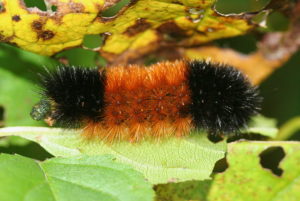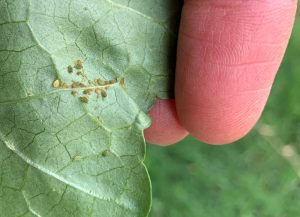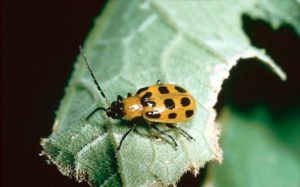Whiteflies are white or cream-colored, triangular-shaped insects that resemble miniature moths. They measure a mere 1/12 of an inch long (2 mm). While there are hundreds of species, there are only a handful that cause problems for home gardeners.
When the weather turns warm, these soft-bodied insects congregate in groups, usually on the underside of leaves, often near the veins. The adults are covered in white mealy wax, hence the name whiteflies. Although they can fly, they are not actually flies, rather they are closely related to aphids and mealybugs.
There are a number of plants that become hosts for whiteflies, including tomatoes, peppers, eggplant, carrots, sweet potato, cabbage, okra, citrus trees, cucumbers, melons, and even houseplants. Some species are plant-specific.
Life Cycle
An adult female lays between 200 and 400 pale yellow eggs on the underside of leaves. The minuscule eggs are often, but not always, laid in a circular or concentric pattern because the female will continue to eat while she lays the eggs.
In five to ten days, the eggs will darken in color and hatch. The tiny larvae, which begin sucking sap right away, will go through four instars (stages) before pupating. One week later, an adult will emerge. The entire process takes between four and six weeks. Adults live only for a few months.
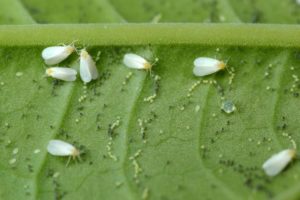
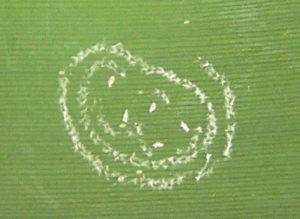
In colder climates, whiteflies cannot survive winter conditions outdoors. However, if plants infested with the pest are overwintered indoors or in a greenhouse, then they are capable of surviving and spreading to other plants. In warmer climates, they can overwinter and even continue to reproduce.
Telltale Signs
Because whiteflies are so small, their presence may go undetected until they are well-established. There are, however, tell-tale signs that can help you determine whether or not whiteflies are present. If you brush up against a plant and you see tiny white insects scatter, chances are, they are whiteflies.
These garden pests usually hide on the underside of leaves and they often lay their eggs along leaf veins. Also, they are drawn to new growth because the plant tissue is more tender than older leaves.
You may notice a sticky residue called honeydew on the plant before you actually see the whiteflies. The sweet substance is excreted by not only whiteflies but by aphids and mealybugs as well. The presence of ants is another tell-tale sign as they are attracted to the honeydew.
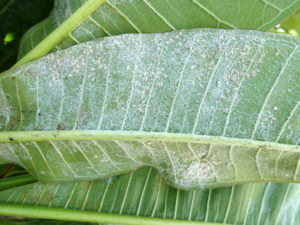
Damage
Whiteflies are problematic for a few reasons. First, they suck the plant’s sap, which causes the plant to weaken. As a result, leaves will wilt, turn yellow, and eventually fall off. Plant growth will also be stunted.
Second, in addition to their honeydew secretions attracting other insects, it is also the perfect breeding ground for a black fungus called sooty mold, which can spread and inhibit photosynthesis, eventually killing the plant.
Third, this tiny white insect is a vector for numerous plant diseases, which can be furthered by the plant’s weakened state.
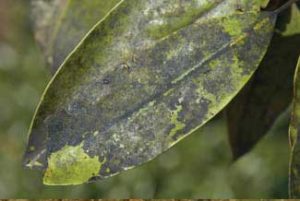
This article contains affiliate links. If you make a purchase using one of these links, I will receive a very small commission at no additional cost to you, and it will help me maintain this website. Rest assured, I only recommend products I actually like!
How to Prevent Whitefly Infestation
Take Care of Your Plants
One of the best ways to combat whiteflies is to grow healthy plants. Plants that are stressed from insect or disease pressure or improper growing conditions are more susceptible to whiteflies.
Routinely Inspect for Unwanted Visitors
Inspect new plants before bringing them into your home or garden, especially ones grown in a greenhouse where whiteflies can be a problem. Also, make a habit out of daily inspecting your garden. It is much easier to eradicate whiteflies before they become a problem. Gently brush up against plants and watch to see if whiteflies scatter. Also, look under leaves for adults, nymphs, and eggs which look like tiny white specs. Check for honeydew and ants as well.
Treatment Methods
There are several natural remedies to help you combat whiteflies. You will need to use a combination of these methods.
Blast of Water
All stages of whitefly development are relatively weak and can be dislodged from the plant by a strong blast of water. Any insects, eggs, or larvae that remain can then be treated.
Insecticidal Soap
Insecticidal soap can be an effective way to get rid of whiteflies and other mealy-coated insects as the soap is able to penetrate the protective wax that covers the bugs. You can make your own insecticidal soap by adding one teaspoon of Castile soap like Dr. Bonner’s or Dr. Wood’s, to a one quart spray bottle filled with water. Or for larger applications, add four teaspoons to one gallon of water in a pump sprayer. Mix well. Do a test spray on one leaf and wait 24-48 hours to see if there are any adverse reactions. If so, dilute the spray and retest. Then spray the plant thoroughly, especially the underside of leaves. Repeat once a week for four weeks until there are no more whiteflies. Do not spray during the day as the combination of soap and sunlight could burn your plants. Keep in mind that insecticidal soap can also be harmful to beneficial insects.
Sticky Traps
Yellow sticky traps are available online in small and large sizes. They are non-poisonous and can be an effective treatment for whiteflies or as a means to detect their presence before they can gain a foothold. The insects will be attracted to the color yellow, and once they land on the trap, will not be able to escape. One drawback is that they can potentially trap beneficial insects like pollinators.
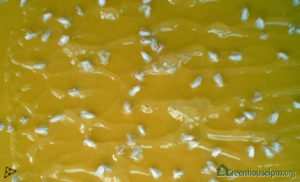
You can make your own sticky traps by coating a yellow index card with petroleum jelly. (Or use a piece of yellow poster board, cardstock, or even a plastic plate or cup as long as they are yellow.) Another option would be to use Tanglefoot Insect Barrier paste or spray instead of the jelly. Use a paper clip or a binder clip and a piece of string to suspend the trap from the infected plant or affix the sticky trap to craft sticks, paint stir sticks, or disposable chopsticks.
Reflective “Mulch”
Reflective mulch, often made from Mylar, is used in gardens and indoor grow spaces to redirect light and minimize hot spots, but it can also be used to control pests. According to numerous sources, the reflective mulch confuses the whiteflies and makes it difficult for them to locate preferred plants.
Beneficial Insects
Beneficial insects like ladybugs, green lacewings, dragonflies, spiders, and damselflies can be very effective at eradicating whiteflies. Many beneficial bugs feed on nectar and pollen so make sure you have these in abundance in order to draw the beneficial insects to your garden.
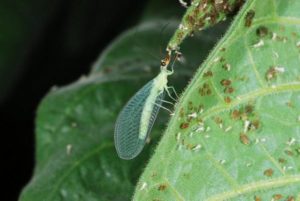
Attract Birds to Your Garden
Hummingbirds, chickadees, warblers, and purple martins are known to eat whiteflies. Attract these and other insect-eating birds to your garden by adding a bird feeder, a source of water for them to drink from, and shelter. Not only will they help keep the insect population down, but they will also keep you entertained.
Garlic Spray
Garlic contains sulfur compounds that repel insects. To make your own spray, take two to three whole garlic bulbs and separate them into cloves. Place them into a blender, add one cup of water and blend thoroughly. Add three more cups of water and several drops of Castile soap, which will help the garlic spray stick to the plant. Blend again until no visible solids remain. Allow the mixture to steep overnight. Strain the mixture using a fine mesh strainer or cheesecloth in order to remove any particles that could clog the sprayer. Mix 1 part of the garlic mixture with 10 parts water. Use a spray bottle to apply. Be sure to do a test spray before covering the plant. If there are any adverse signs, dilute the spray with more water and test again. This spray can also harm beneficial insects so use caution.
Neem Oil
Neem oil is derived from the seeds of the neem tree, an evergreen from India and Southeast Asia. Choose a pure, cold-pressed neem oil that contains Azadirachtin, a naturally occurring compound that makes the oil more effective. This is the neem oil that I use.
Neem oil acts as an antifeedant and a hormone disrupter, preventing nymphs from developing and adults from reproducing. It can also smother eggs.
Make your own spray by mixing 1-2 teaspoons of pure, cold-pressed containing Azadirachtin, with 1/2 teaspoon of Castile soap like Dr. Bonner’s or Dr. Wood’s, and 1 quart of water. Mix well. Do a test spray test on a leaf and wait 24 to 48 hours before spraying the rest of the plant, especially the underside of leaves. Repeat once a week for four weeks so as to break the insect’s life cycle. Do not spray during the day as the combination of sun and oil could burn your plants. Be aware that neem oil can also be harmful to beneficial insects.
Plant a Trap Crop
Flowers can be used as a trap crop to lure whiteflies and other insects away from your prized plants. Nasturtiums will attract sap-sucking insects while French marigolds (or other scented marigold varieties) are said to deter them because of their scent. Plant these flowers strategically in your garden. Thyme is another aromatic crop that reportedly repels insects, whiteflies in particular.
Vacuum
Some recommend using a hand-held vacuum a few times a week to remove whitefly adults, nymphs, and eggs until the situation is resolved. You will need to vacuum in the morning when the whiteflies are less active and be careful not to damage the plant. Remember to empty the contents of the vacuum in a trash bag outside.
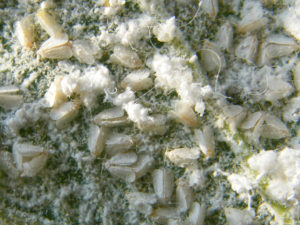
Remove Leaves or the Entire Plant
If there is a heavy infestation, remove the leaves that are infected and dispose of them in a plastic bag. Or, if the plant is completely covered in whiteflies, it may be advisable to remove the entire plant and dispose of it in a plastic bag so that the infestation does not spread to other plants.
Whiteflies can more than just a nuisance, they can destroy plants. The sooner you are aware of a problem, the easier and more effective these treatment methods will be.
Thank you for reading this article! If you found it helpful, please consider sharing it with others via email or social media!
